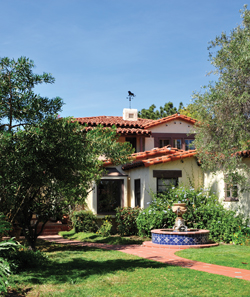|
Alphabet Soup
The acronyms that impact our neighborhoods
By Dionné Carlson
 Casa Encantada (1926/1928), one of a rare pair of Spanish Eclectic "Mirror" homes, designed to face each other across an open courtyard. Photo by Sandé Lollis |
When I first got sucked into the volunteer-world vortex of local community planning groups, one of the things I found most intimidating were all the acronyms. Everyone involved seemed to speak an arcane and incomprehensible shorthand, and seemed to take for granted that I would know what they were talking about. Not being an attorney, and never having worked in government circles, I did not.
Terms such as CPG (community planning group), BID (business improvement district), MAD (maintenance assessment district), PAC (redevelopment project area committee) and PROW (public right of way) were all a mystery to me. As I sat fascinated in community planning group meetings, all these terms and what they represent were eventually explained and I learned them all.
And taking the COW - what did you call me? - (community orientation workshop) really helped too. Did you know the City of San Diego puts on this free workshop to orient and educate current and potential community planning group members at least once a year? You don't have to be on a planning committee to attend-you can just sign up if you are interested. The COW is also available online.
I first got involved with my local planning group in an effort to save historic homes in my neighborhood from the wrecking ball. When the Academy of Our Lady of Peace first unveiled their "modernization plan" a few years ago, it involved the removal of three historic homes from our single-family neighborhood and the construction of a large, unwelcome parking structure in their place. Alarmed, my neighbors and I studied the North Park Community Plan (you can find yours at https://www.sandiego.gov/planning/community/profiles/index.shtml) and were relieved to learn it contains strong protections for historic resources and community character. But we were crushed to discover how easily a savvy developer can bypass this city-ratified plan. None of us had real expertise in land-use issues, or in historic preservation, so we had to learn more of those terms, such as HRB (historic resources board), EIR (environmental iA8A8A8mpact report) and CUP (conditional use permit).
SOHO (Save Our Heritage Organisation) and the NHPC (Neighborhood Historic Preservation Coalition) taught us that CEQA (California Environmental Quality Act) is often the last b astion between a historic resource and the wrecking ball. CEQA requires state and local agencies to identify a project's significant environmental impacts and to avoid or mitigate those impacts if feasible. Impacts to historic resources are considered an environmental impact under CEQA.
And now we are learning about RLUIPA (Religious Land Use and Institutionalized Persons Act). Who knew that, under this federal law, religious institutions can attempt to claim exemptions from certain city land-use regulations that secular institutions cannot? Since President Clinton signed RLUIPA into law in 2000, the filing of RLUIPA cases against local governments has become a frequent tool for developers to get around the environmental protections for historic resources that CEQA and local community plans impose. An article about my own neighborhood's ongoing case recently appeared at https://blog.preservationnation.org/?s=Our+lady+of+peace on the blog for the National Trust for Historic Preservation.
There is nothing like fighting a land-use battle on one's home turf to underline the importance of participating in this process. I suggest you don't wait until you have one on your hands in your neighborhood to get educated. You don't need to be an established "pillar of the community" to participate, nor do you need a degree in urban planning. Right now, our local planning areas of Uptown, North Park and Golden Hill are conducting a two-year Community Plan Update process, with monthly meetings that comply with the Brown Act, which means the meetings are open to the general public and provide opportunity for public comment. At these meetings community members offer feedback to the city on what we prefer to see in our new community plans. Visit https://www.sandiego.gov/planning/involved/index.shtml to find out more about getting involved in community planning.
While the planning and land-use process can be frustrating at times, the frustrations don't outweigh the rewards and satisfaction of participating in efforts to improve (or just preserve) one's community. One of my rewards has been meeting other engaged and interesting people in my neighborhood and at CPUAC meetings. "America's Finest City" is changing quickly. By participating in the community plan update process, we can help plan how our city will change and grow to keep up with new technologies and ideas in urban planning, while still fighting to preserve things such as our canyons, open space, parks, single-family communities and historic resources-the things that make living in a community like San Diego such a privilege and joy.
This article was originally published in San Diego Uptown News on July 9, 2010
About the Author A recently elected board member of the North Park Planning Committee, SOHO member Dionné Carlson lives in the Between Heights neighborhood of San Diego (BeHi) and is active in other planning and preservation committees. |
MORE FROM THIS ISSUE
From the Editor
The Cosmopolitan Hotel: A Resurrection of the Past
Most Endangered List of
Historic Resources
Lead Paint: What's at Stake?
The California Theatre Under Siege
10-Year Anniversary at the Whaley House
Marston House - First Year Retrospective
People In Preservation Winners
An Evening Well Spent at PIP
Preservation Community
Reflections
Book Review
Strength in Numbers
Donations 2010
Lost San Diego
Advertisements
DOWNLOAD full magazine as pdf (15.4mb)
|




